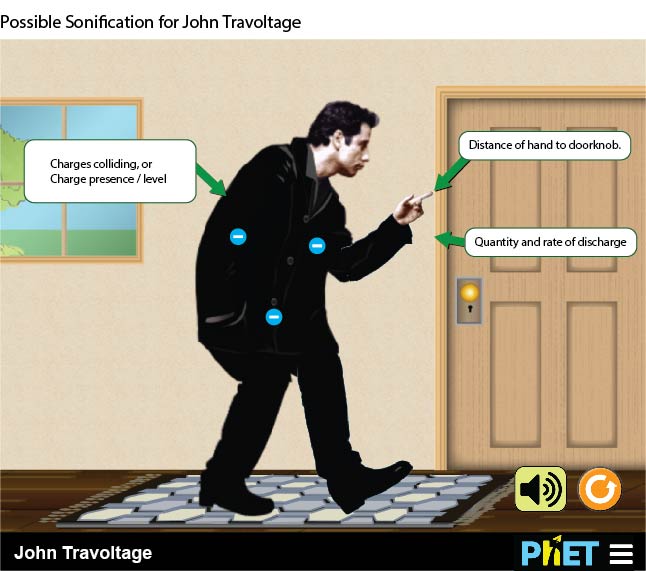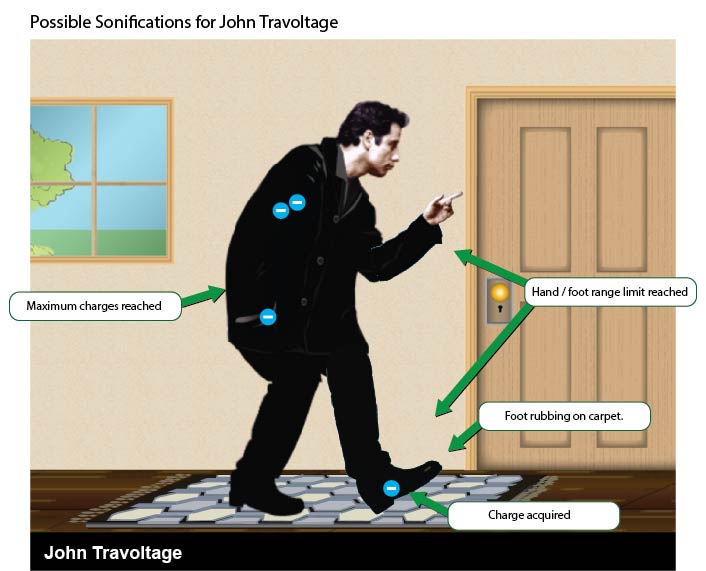
Sonification refers to the audio representation of data, this should not be confused with sound effects which is an audio representation of an event.
The a development version of John Travoltage sim with sonification and accessibility can be found on the PhET development website.

Hand proximity to the doorknob:
Charge presence:
Discharge of electrons: quantity and rate

Charge Acquired
Foot rubbing on carpet
Maximum charges reached
Maximum range reached for hand and foot
Quantity of charge
Collision of charges
Personal Goals:
Graduate and go to college or university
Keep up with her Physics class and participate fully
Making effective use of time
Practical Goals:
Understand current electricity unit in Physics
Chloe is a busy high school student. Like most of her friends, she’s feeling the pressure of graduating high school, balancing her academics with her social life, and somehow find time to do the things she loves to do like being part of the school’s chess and robotics clubs. For the most part she enjoys everything about high school except for the fact she doesn’t have enough time to do all the things she wants to do. As a result, she’s finding that she has to cut time away from her clubs, or rush her homework.
Chloe is taking physics this year and thankfully her teacher has done his best to offer the course material in multiple formats and modalities. She finds it useful to hear a podcast or listen to a YouTube video to compliment the text material. However, one of her challenges is following along during applied activities. While her classmates do their best to work collaboratively, Chloe often finds it difficult to follow especially during the excited, frantic discovery process. Chloe wishes there was some way she can do the same (or similar) experiments outside of class and at her own pace.
In Chloe’s physics class they are covering static electricity and today’s examined static discharge by experimenting with some wool, a balloon, a paperclip, and some tape (reference: see here for how this experiment is done). Chloe had a tough time doing and following this experiment in class. To top it off, Chloe couldn’t tell how close she was to the paperclip and burst the balloon. At the end of class their teacher gave a link to some online resources, one of them was a link to the John Travoltage simulation on PhET.
At home after dinner, Chloe settles down in front of her laptop and loads up the John Travoltage simulation. Doing a quick survey of the simulation with her screen reader, she could tell that there is some descriptive text at the start, then two sliders, and a few other options. Going on a hunch, Chloe selects the “Foot” slider and moves it one spot. Her screen reader reports back that the foot position has changed and is off the carpet. Intrigued, Chloe presses moves the slider a few more times and at some point she hears a different sound. Her screen reader told her that a “charge was acquired” and there was a chirping sound at the same time.
Moving the slider more vigorously now, she hears rapid chirping sounds along with the feedback from her screen reader saying that the foot has moved and a charge has been gained. Suddenly Chloe hears a zapping, buzzy noises followed by what could only be described as “inverted charge acquired chirps”. Her screen reader announces that a discharge occurred and there are “no more charges”.
Not quite sure what happened because her screen reader was also talking the same time these other sounds were playing, Chloe moves the foot slider more slowly and deliberately. With each “charge acquired chirp”, she can hear the screen reader report back the quantity of charges: “31 charges now acquired. 32 charges….”.
Chloe hears something she had not noticed before - she can hear subtle clinking noises now. She wonders if the reason she did not hear them before is because too much was going on earlier?
Slowly Chloe moves the slider to get a few more charges - the screen reader reports back that charges were acquired, and she can also hear that the clinking is more frequent (she thinks “it seems to be related to the number of charges?”).
At the 51 charge mark Chloe hears the zappy, buzzy noises she had heard earlier and the screen reader reporting that there was a discharge.
Satisfied with the outcome, Chloe starts to use the hand slider. The screen reader is reporting that the hand is changing position closer and then further away from the doorknob, but nothing much else is happening. Puzzled, she re-examines the contents of the page, but then recalls her lesson in class.
Moving back to the foot slider, Chloe starts to vigorously gather charges moving the slider rapidly. She hears a noise and a notification from the screen reader that there are 100 charges and that the maximum number of charges had been gained. Half expecting something to have happened by this point, Chloe remembers that she had left the hand far away from the door knob. Tentatively at first, Chloe moves the hand closer to the door knob, but starts moving more quickly. Position 35… 36 ...
Suddenly there was a zapping, buzzing noise - the electrons were being discharged! Chloe shocked that it happened so quickly, reverses the direction of the hand movement. The sound continues for a moment longer and then stops. The screen reader reports that electrons were discharged and that 23 remained.
Feeling unsure of herself, Chloe thinks that she needs to experiment with this a little more, but there’s other homework to do first. Making a mental note to come back, Chloe sets her computer aside and goes to grab a drink.